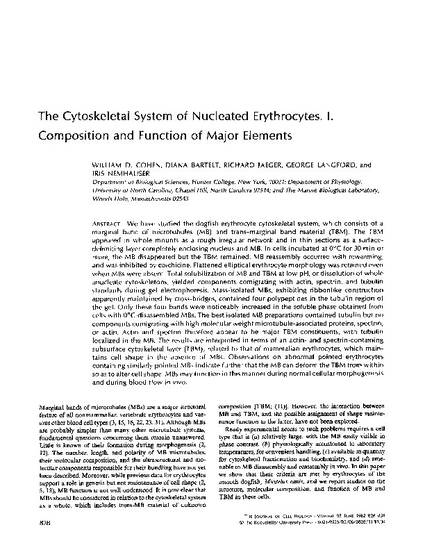
- Actins,
- analysis,
- Animals,
- Cell Nucleus,
- ultrastructure,
- Colchicine,
- pharmacology,
- cytoskeleton,
- analysis,
- physiology,
- Dogfish,
- blood,
- Erythrocyte Membrane,
- Erythrocytes,
- Hydrogen-Ion Concentration,
- Microtubules,
- Sharks,
- Spectrin,
- Temperature,
- Tubulin
We have studied the dogfish erythrocyte cytoskeletal system, which consists of a marginal band of microtubules (MB) and trans-marginal band material (TBM). The TBM appeared in whole mounts as a rough irregular network and in thin sections as a surface-delimiting layer completely enclosing nucleus and MB. In cells incubated at 0 degrees C for 30 min or more, the MB disappeared but the TBM remained. MB reassembly occurred with rewarming, and was inhibited by colchicine. Flattened elliptical erythrocyte morphology was retained even when MBs were absent. Total solubilization of MB and TBM at low pH, or dissolution of whole anucleate cytoskeletons, yielded components comigrating with actin, spectrin, and tubulin standards during gel electrophoresis. Mass-isolated MBs, exhibiting ribbonlike construction apparently maintained by cross-bridges, contained four polypeptides in the tubulin region of the gel. Only these four bands were noticeably increased in the soluble phase obtained from cells with 0 degrees C-disassembled MBs. The best isolated MB preparations contained tubulin but no components comigrating with high molecular weight microtubule-associated proteins, spectrin, or actin. Actin and spectrin therefore appear to be major TBM constituents, with tubulin localized in the MB. The results are interpreted in terms of an actin- and spectrin-containing subsurface cytoskeletal layer (TBM), related to that of mammalian erythrocytes, which maintains cell shape in the absence of MBs. Observations on abnormal pointed erythrocytes containing similarly pointed MBs indicate further that the MB can deform the TBM from within so as to alter cell shape. MBs may function in this manner during normal cellular morphogenesis and during blood flow in vivo.